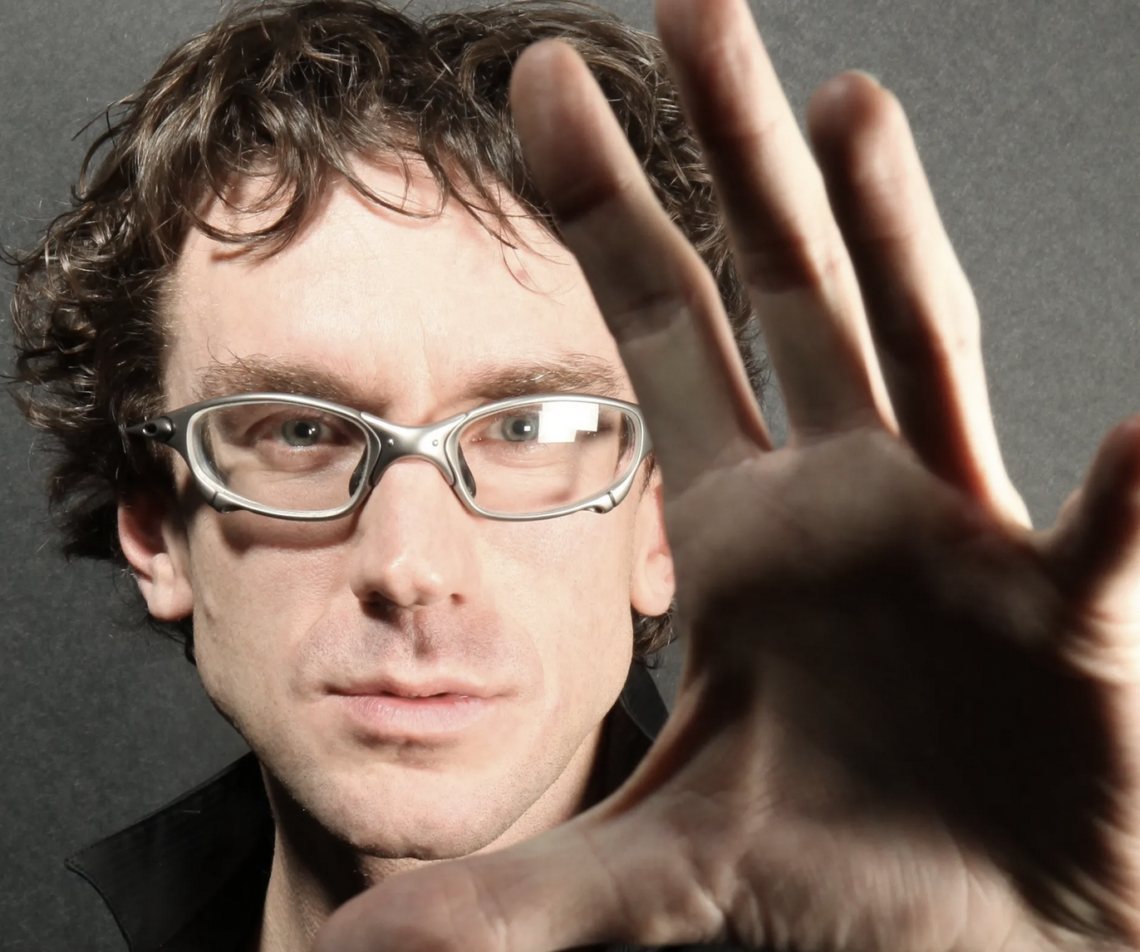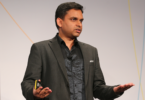Pablos Holman is a hacker, inventor and technology futurist. His projects include cryptocurrency in the 1990s; AI for stock market trading; building spaceships at Blue Origin for Jeff Bezos and the world’s smallest PC and 3D printers at Makerbot. Holman helped start the Intellectual Ventures Lab for Nathan Myhrvold, a former Chief Technology Officer at Microsoft, to support a wide range of invention projects, including a brain surgery tool; a machine to suppress hurricanes; a nuclear reactor powered by nuclear waste; and a machine that can shoot mosquitoes out of the sky with lasers – part of an impact invention effort to eradicate malaria with Microsoft Co-founder Bill Gates, the co-founder of the Bill and Melinda Gates Foundation.
Holman, who has over 70 patents, is a world-renowned expert in 3D printing, artificial intelligence, Big Data, robotics, automated manufacturing, and crypto, He has contributed to visions for the future of urban transportation, entertainment, education, energy, manufacturing, health care, food delivery, sensor networks, payment systems and Cloud computing. His TED talks have over 30 million views.
Currently, Holman is Managing Director at Deep Future, a U.S.venture firm with a stated mission of “backing mad scientists, rogue inventors, crazy hackers and maverick entrepreneurs implementing science fiction and solving big problems.” He recently spoke to The Innovator about what’s next in technology and why it is important for corporates to team with startups to work on the world’s biggest problems.
Q: What’s next in tech?
PH: Nobody on earth is smart enough to know what is going to work in the future. It takes experimentation. Silicon Valley is a machine that runs thousands of million-dollar experiments. We try everything and then double down on what works and invest in that The reason we do that is that if you look at what happens when you invent in a new technology that lives up to its potential and is 10x, 100x or a 1000x cheaper it is a force multiplier that can change the way we do things and make them faster, cheaper, greener and more humane. I don’t find force multipliers looking at business models or government policies, but I find them all the time in new technologies.
Q: Can you give an example?
PH: AI-powered cargo ships, made by our company Ladon Robotics, that are autonomous and sail with no crew, no fuel, and no emissions. Creating autonomous sailing ships is a lot easier than developing self-driving cars. There is a strong incentive to develop them. About $5 out of every $6 dollars spent on shipping today is burned as fuel, the rest is spent on the ship, the crew, and the port. Before COVID shipping from China to Los Angeles took 50 days door to door: only 14 of them on the water. That part is 30% slower when you are sailing. During COVID the same trip took up to 120 days, with again only 14 days on the water. The reason is ports are backed up because of massive cargo ships. These ships are massive because the larger size provides a 50% improvement on drag, reducing fuel costs per container. If you don’t have fuel costs you don’t have to make the ships so big and that would improve circulation in ports. Today cargo ships have two gas tanks, one with refined fuel, and another with nasty bunker oil, which they use as soon as they are over the horizon. These cargo ships are optimized for carbon emissions. The maritime industry has set emission standards and targets, but they have no clue how they are going to meet them. I encourage the industry to partner with Ladon Robotics to help pilot these smaller, more economic, emission-free autonomous sailing ships, which don’t need fuel and only use electricity in dead zones. The maritime industry is one of the biggest emitters of greenhouse gases so the impact of adoption would be huge.
Q: What are some of the other new disruptive technologies that excite you?
PH: Solar arrays in space. Virtus Solis, one of our portfolio companies, is commercializing this technology as fast as possible. Solar panels orbiting Earth get sun 24×7, 365 days a year. They receive 8x as much energy as terrestrial panels. They can beam power down to Earth anywhere on the planet using radio waves, even in the middle of the night and right through clouds. All you need on the ground is a big antenna. The idea has been around for a while but the cost of launching them into space was prohibitive. That is changing. SpaceX has gotten launch cost down 20x from the Space Shuttle. They’re at $2300 per kilogram. Virtus Solis’ idea becomes exceptionally cost effective at about $300 per kilogram. The SpaceX target for Starship is $20 per kilogram. I am predicting that something measured in years, not decades, space solar will become the lowest cost baseload energy anywhere on Earth.
Another of our teams, DMAT, which is based in Italy, recently solved a 2000-year-old mystery. How did the Pantheon, which is made of non-reinforced concrete and was built in a seismic zone, remain standing after 2000 years, while our concrete, reinforced with steel, crumbles in 50 years? No one has been able to figure it out for two millennia, but DMAT’s team solved this question while at MIT and published a paper about it in Science in January. Now we know how to make cement that will last virtually forever, requires smaller amounts and less steel, doesn’t cost more, and emits 20% less CO2 emissions. This is important because this radically reduces the carbon emissions from making cement, which is the largest offender of all construction materials, almost 9% of global CO2 emissions and growing. Cement plants cost around $100 million to build. There are about 4000 in the world, and they are going to run for another 50 years or so. While there are lots of ideas about how to change cement you can’t get them to market because there is no money for building new plants. DMAT’s formula can be made in existing cement plants. With no retrofitting costs you get cement that is cheaper, stronger, and greener. Anyone who is building roads, bridges or in charge of any kind of construction project should talk with DMAT.
Q: You have been disrupting manufacturing for a while with various projects. What changes do you see in this sector?
PH: 3D printing for manufacturing has largely failed to live up to expectations. Marvel Labs is out to change that with the lowest cost 3D printing for durable goods. It invented a way to 3D print products out of biomass. It is printing sinks, light fixtures, bicycles, and coffee cups out of used coffee grounds, wood waste or seaweed. The products they make sequester carbon and keep biomass out of landfills. Deep Future is proud to be their first investor. With a backlog of purchase orders, this team is going straight into production. If you want to build the future of manufacturing in Europe or Asia please reach out to Marvel Labs (For more on Marvel Labs see The Innovator’s separate story about the company.)
Q: What is your advice to corporates?
PH: My view is we are giving all the companies the wrong message: you need to innovate or die. The dying part they understand but innovation is not really what they are good at. If you look at the people who actually innovate, they didn’t learn it in a workshop or seminar. They are people who think differently, and they don’t want to work for big companies. Back in the 1980s every Fortune 500 company created R &D divisions and the people working there job was to invent the next generation of tech for that industry. They lost over and over again to two guys in a garage, The Fortune 500 learned from that and shut down their R&D and replaced it with M&A. So, my message to big corporates is play to your strengths. If you are an operator of a big shipping company you know how to manage large operations and handle distribution, Startups suck at that. Startups are good at trying new things and navigating all the technical challenges so figure out how to partner with them and stop hanging out with people from your own industry. It is crucial if you want to preserve your job and your business. Startups are an existential threat. If their solution is a 100x multiplier or a 1000x multiplier they will replace you sooner or later. Decide which side of history you want to be on. New technologies are the force multipliers with the ability to make a difference in the world. Partner with companies creating these technologies and become a co-conspirator that will help to bring these things to life.
This article is content that would normally only be available to subscribers. Sign up for a four-week free trial to see what you have been missing.







